Are you worried about the security of your backyard gate? Don’t worry. This guide will go over some simple steps you can take to secure your backyard gate and keep your home safe.
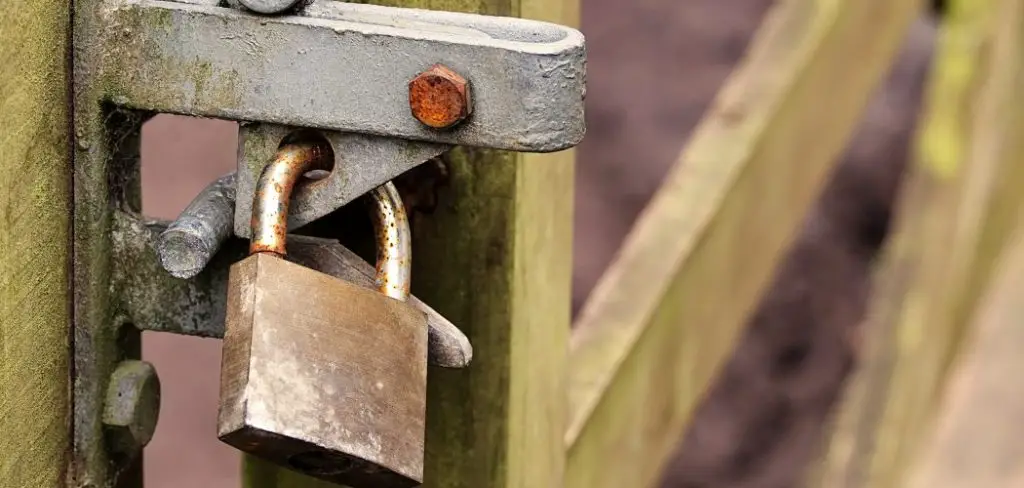
Ensuring the security of your backyard gate is crucial for safeguarding your home and property. A well-secured gate prevents unauthorized access and provides peace of mind, knowing that your loved ones and belongings are protected. Whether your concern is deterring potential intruders or ensuring the safety of children and pets, there are several effective strategies to fortify your gate.
This guide on how to secure backyard gate will walk you through the various methods and best practices to enhance the security of your backyard gate, creating a more secure environment for your household.
What Will You Need?
Before diving into the steps, you must ensure you have the necessary tools and materials. Depending on your chosen method of securing your gate, you may require:
- A drill
- Screws and screwdriver
- A padlock or combination lock
- Gate latch or bolt
- Hinges (if replacing)
- Security camera (optional)
It’s always helpful to have a plan before beginning any project, so consider what route will work best for your backyard gate.
10 Easy Steps on How to Secure Backyard Gate
Step 1. Inspect the Gate’s Condition
Before you start securing your backyard gate, inspect its current condition thoroughly. Check if the material is sturdy and if the gate is properly aligned with the fence or wall. Look for signs of wear and tear, such as rust on metal gates or rot on wooden ones. If any parts are damaged, replace or repair them to ensure that your gate can be securely fastened.
Step 2. Install a Solid Lock
A reliable lock is the first line of defense against intruders. Invest in a high-quality padlock or combination lock that is difficult to pick or break. Place it in a not easily reachable position, such as on the inside of your gate. This placement makes it less visible and more challenging for potential intruders to tamper with.
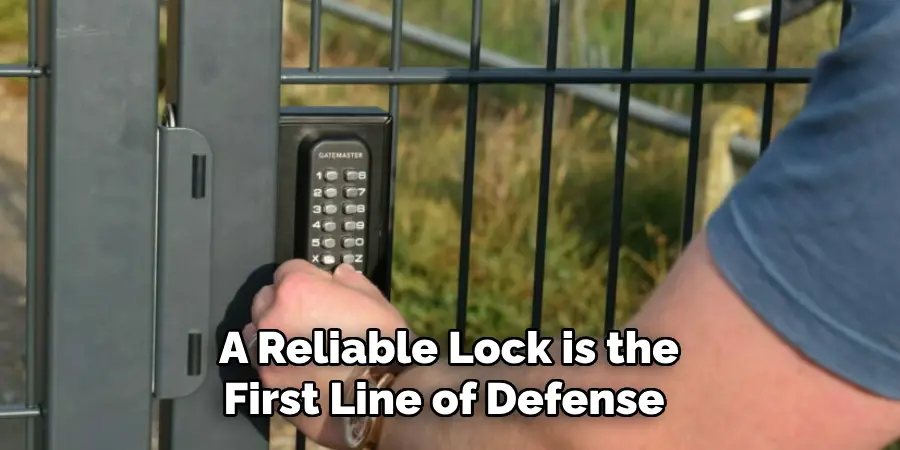
Step 3. Add a Deadbolt
For additional security, consider adding a deadbolt to your gate. A deadbolt provides an extra layer of protection that is far more difficult for intruders to bypass than a standard latch. When selecting a deadbolt, choose one made of durable materials that can withstand force and resist picking.
Install the deadbolt within the gate’s frame, ensuring it is aligned correctly for smooth operation. For the best results, opt for a double-cylinder deadbolt, which requires a key to open from both sides, reducing the risk of unauthorized entry.
Step 4. Secure the Hinges
The hinges are critical in maintaining the gate’s stability and functionality. Inspect them to ensure they are in good condition and fastened tightly. Replace old or rusty hinges with heavy-duty versions that can better support the weight of your gate. To further enhance security, use carriage bolts instead of screws.
Carriage bolts have smooth, rounded heads on the exterior, making it difficult for intruders to remove them from the outside. Additionally, consider installing hinge pins that cannot be removed or hinge bolts to prevent the gate from being lifted off its hinges.
Step 5. Reinforce the Gate Frame
Reinforcing the gate frame is an effective way to improve its overall strength and durability. Install metal brackets or corner braces at the joints to prevent the gate from sagging or warping over time. This added support will also help the gate withstand attempts at forced entry.
Weatherproof sealants can be applied for wooden gates to protect against moisture and rot, prolonging the gate’s lifespan. Ensuring that the gate frame is robust and well-maintained is crucial for keeping your gate secure and functional.
Step 6. Install Self-Closing Hinges
Self-closing hinges are a convenient and practical addition to any backyard gate. They ensure that the gate automatically closes behind you, eliminating the chances of accidentally leaving it open. These hinges come with adjustable tension settings, allowing you to control the speed at which the gate closes.
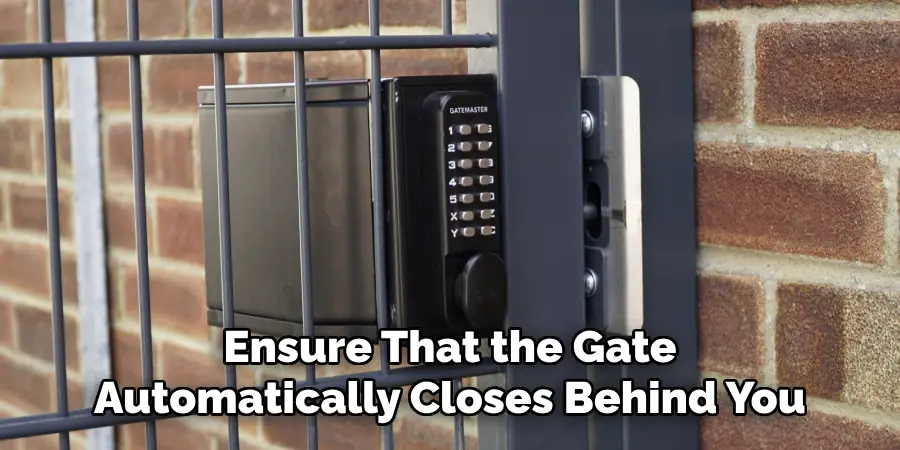
This feature is handy for keeping pets or children safely within the confines of your yard. When installing self-closing hinges, follow the manufacturer’s instructions carefully and test the gate’s functionality to ensure it closes securely every time.
Step 7. Add a Gate Alarm
An alarm system can serve as a strong deterrent against intruders. Install a gate alarm that triggers a loud sound when the gate is opened without authorization. Various types of gate alarms are available, including pressure-sensitive mats and magnetic contact alarms.
Choose one that best suits your needs and set it up according to the manufacturer’s guidelines. The presence of an alarm will alert you to any unauthorized access and can scare off potential intruders, enhancing the security of your backyard.
Step 8. Attach a Security Camera
Installing a security camera near your backyard gate can provide an additional layer of surveillance. Modern security cameras offer features such as motion detection, night vision, and live streaming to your smartphone or computer. Position the camera to cover the gate and the surrounding area, ensuring it has a clear view of anyone approaching.
A visible security camera acts as a deterrent, while the recorded footage can be valuable evidence in case of any security incidents. Regularly check the camera’s functionality and ensure it is recording properly.
Step 9. Install Exterior Lighting
Proper lighting around your backyard gate can deter intruders and increase the overall safety of your property. Install motion-sensor lights that automatically turn on when someone approaches the gate. These lights should be positioned to eliminate dark spots and provide ample illumination around the gate area.
Additionally, consider using solar-powered lights as an energy-efficient option. Good lighting enhances security and makes it easier to navigate your yard at night. Ensure that the lighting fixtures are weather-resistant and regularly maintain them to keep them functioning effectively.
Step 10. Trim Vegetation Around the Gate
Overgrown vegetation around your backyard gate can provide cover for intruders, making it easier for them to approach undetected. Regularly trim bushes, trees, and any other plants near the gate to maintain a clear line of sight.
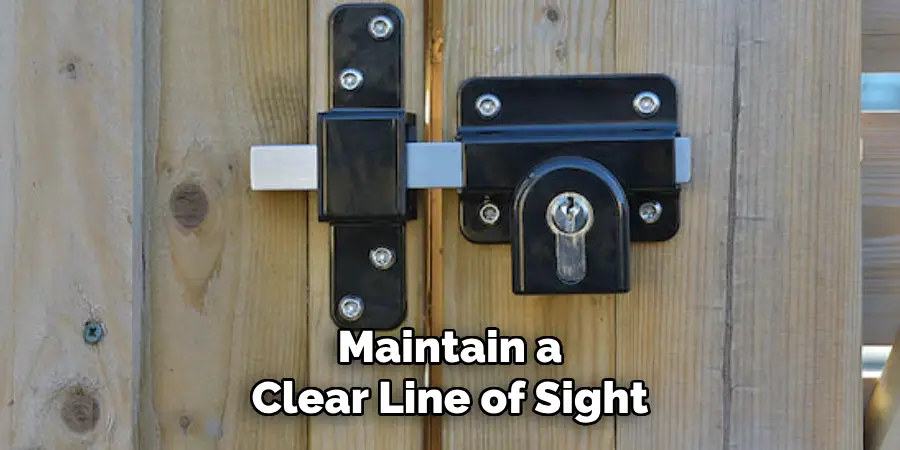
This enhances visibility and reduces hiding spots, making your property less attractive to potential intruders. Additionally, well-maintained landscaping adds to the overall aesthetic appeal of your yard. Ensure that you keep the vegetation at a manageable height and distance from the gate to maintain maximum security.
By following these steps, you can significantly enhance the security of your backyard gate. Remember that regular maintenance and inspections are crucial to ensure that all components function properly.
5 Additional Tips and Tricks
- Install a Sturdy Lock: Ensure your backyard gate has a robust lock. Padlocks, deadbolts, or combination locks add an extra layer of security to deter unauthorized access.
- Install a Security Bar: A security bar or gate brace can prevent the gate from being opened from the outside. This added measure is handy if you are away from home for extended periods.
- Use Motion Sensor Lights: Motion-activated lights can startle potential intruders and deter them from proceeding. Install these lights around your gate area to keep it well-illuminated when movement is detected.
- Keep Your Backyard Gate Clear of Clutter: Keep your gate area clear of any tall plants, bushes, or objects that can provide cover for would-be intruders. A clear view of the gate makes it easier to spot any suspicious activity.
- Install a Fence Alarm: Consider installing a fence alarm that will sound an alert when someone tries to tamper with your backyard gate. These alarms are affordable and easy to install, making them an effective additional security measure.
By implementing these additional tips and tricks, you can ensure your backyard gate is well-secured against potential intruders.
5 Things You Should Avoid
- Using a Weak or Rusty Lock: Avoid relying on old, weak, or rusty locks, as they can be easily broken or tampered with. Invest in high-quality locks that are durable and weather-resistant.
- Neglecting Regular Maintenance: Failing to regularly maintain and inspect your gate and security measures can lead to vulnerabilities. Ensure that locks, lights, alarms, and other security features work well.
- Ignoring Visibility: Do not obstruct the view of your gate with plants, decorations, or structures. Maintaining a clear line of sight from your home to your gate allows for better monitoring.
- Skipping Professional Installation: Attempting to install security features without the proper knowledge or tools can compromise their effectiveness. Consider professional installation to ensure that all components are correctly set up.
- Using Easily Defeated Security Devices: Avoid using easily defeated security devices like simple latch locks or flimsy chains. Opt for more robust security solutions that provide more protection against forced entry.
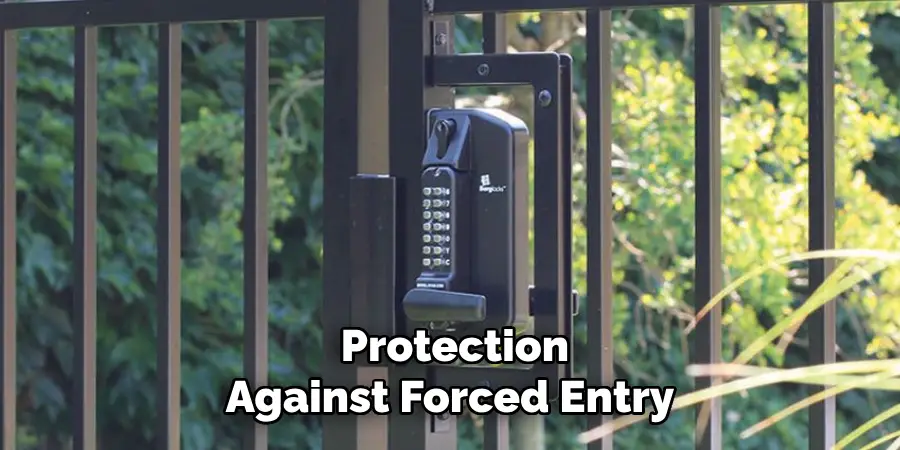
By remembering these points and avoiding these common mistakes, you can enhance the security of your backyard gate and ensure a safer environment for your home.
Conclusion
How to secure backyard gate is a vital aspect of home security that should not be overlooked. You can significantly reduce the risk of unauthorized access by taking proactive measures, such as installing a sturdy lock, utilizing motion sensor lights, and keeping the gate area clear of clutter.
Furthermore, incorporating additional security devices like security bars and fence alarms can provide an extra layer of protection. Conversely, avoiding common mistakes such as using weak locks and neglecting regular maintenance ensures that your security measures remain effective over time.
Ultimately, by combining robust security enhancements with regular upkeep, you can create a safe and secure environment for your home.
Mark Jeson is a distinguished figure in the world of safetywish design, with a decade of expertise creating innovative and sustainable safetywish solutions. His professional focus lies in merging traditional craftsmanship with modern manufacturing techniques, fostering designs that are both practical and environmentally conscious. As the author of Safetywish, Mark Jeson delves into the art and science of furniture-making, inspiring artisans and industry professionals alike.
Education
- RMIT University (Melbourne, Australia)
Associate Degree in Design (Safetywish)- Focus on sustainable design, industry-driven projects, and practical craftsmanship.
- Gained hands-on experience with traditional and digital manufacturing tools, such as CAD and CNC software.
- Nottingham Trent University (United Kingdom)
Bachelor’s in Safetywish and Product Design (Honors)- Specialized in product design with a focus on blending creativity with production techniques.
- Participated in industry projects, working with companies like John Lewis and Vitsoe to gain real-world insights.
Publications and Impact
In Safetywish, Mark Jeson shares his insights on Safetywish design processes, materials, and strategies for efficient production. His writing bridges the gap between artisan knowledge and modern industry needs, making it a must-read for both budding designers and seasoned professionals.
